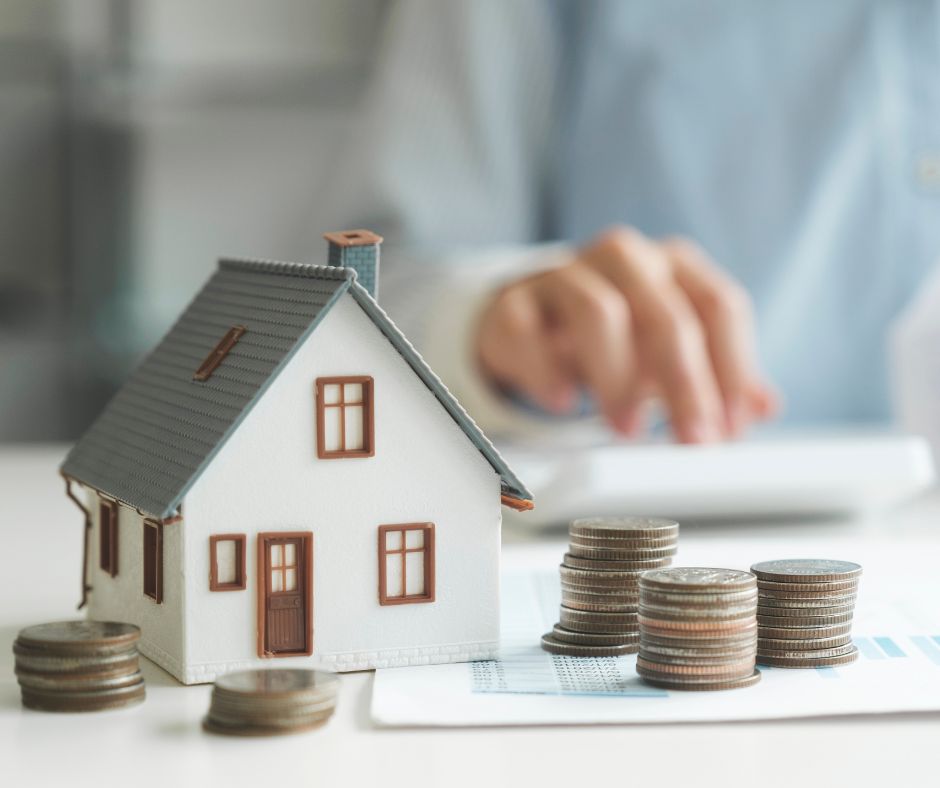The Secret To Selling Your House in Today’s Market

A few years ago, homes were flying off the shelves and getting multiple offers well over their asking price. It felt like you could name your price and still have buyers lined up at the door.
But today’s housing market is different. Buyers are getting more selective now that inventory has grown. Homes are sitting a little longer. And more sellers are having to cut their prices.
So, how do you still come out on top? It all starts with one thing, pricing your house right from the start. Today, that matters more than ever – and it can make or break your sale.
There’s a Real Price Disconnect Between Buyers and Sellers
A recent survey from Realtor.com shows 81% of home sellers believe they’ll get their asking price or more. But the actual sales data shows there’s a growing gap between what sellers expect and what buyers are actually willing to pay.
In fact, an annual report from the National Association of Realtors (NAR) shows 44% of recently sold homes went for less than the asking price. And 1 in 3 sellers had to cut their price at least once before the home sold. It’s a sign that expectations may be a little out of step with today’s reality.
Check out the graph below. It uses data from Redfin to show that asking prices (blue line) are higher than actual sales prices (green line) by a wider and wider margin:
This tells you something important: not all buyers are willing to pay what many sellers are asking. That doesn’t mean you can’t sell for a great price – but it does mean you need to start with a price that reflects what people are willing to pay in today’s market.
What Happens When You Overprice Your House?
Pricing your house high initially may seem like a smart move, so you have more room to negotiate. But the reality is, an overpriced home can sit on the market and turn buyers away.
Buyers are smart. And when they see a house that’s been sitting for a while, they start to wonder what’s wrong with it. That can lead to fewer showings, less interest, and eventually, a price cut to re-ignite attention. As Realtor.com explains:
“By getting the right price early on, you can increase the odds buyers will be interested in the home. In turn, this decreases the chances the home will sit on the market for a lengthier timeline, also reducing the odds you’ll need to lower the listing price.”
The longer a house sits, the harder it can be to sell.
You Still Have a Great Opportunity – If You Price Your House Right
To avoid making this mistake, it’s important to lean on an agent who knows what’s happening locally when you set your asking price.
Your agent will look at recent local sales, buyer trends, and inventory levels to find that pricing sweet spot for your neighborhood – because it’s going to be different based on where you live.
And here’s something else to keep in mind, home prices have climbed more than 57% over the past five years. So, even if you price a bit below the number you had your sights set on, you’ll likely still be in a great position profit-wise.
With a local real estate agent’s help, you’ll attract more attention, avoid seeing your house sit on the market too long, and maximize your chances of getting a strong offer.
In today’s market, the right price works. As Mike Simonsen, Founder of Altos Research, explains:
“. . . the best properties, well priced are selling quickly in most of the country.”
Bottom Line
The market has changed, but your opportunity to sell hasn’t. You just need the right pricing plan. Let’s talk and I can go over what’s happening with prices in our area and determine what price would help your house sell quickly and for top dollar.
Why Would I Move with a 3% Mortgage Rate?

If you have a 3% mortgage rate, you’re probably pretty hesitant to let that go. And even if you’ve toyed with the idea of moving, this nagging thought may be holding you back: “why would I give that up?”
But when you ask that question, you may be putting your needs on the back burner without realizing it. Most people don’t move because of their mortgage rate. They move because they want or need to. So, let’s flip the script and ask this instead:
What are the chances you’ll still be in your current house 5 years from now?
Think about your life for a moment. Picture what the next few years will hold. Are you planning on growing your family? Do you have adult children about to move out? Is retirement on the horizon? Are you already bursting at the seams?
If nothing’s going to change, and you love where you are, staying put might make perfect sense. But if there’s even a slight chance a move is coming, even if it’s not immediate, it’s worth thinking about your timeline.
Because even a year or two can make a big difference in what your next home might cost you.
What the Experts Say About Home Prices over the Next 5 Years
Each quarter, Fannie Mae asks more than 100 housing market experts to weigh in on where they project home prices are headed. And the consensus is clear. Home prices are expected to rise through at least 2029 (see graph below):
While those projections aren’t calling for big increases each year, it’s still an increase. And sure, some markets may see flatter prices or slower growth, or even slight dips in the short term. But look further out. In the long run, prices almost always rise. And over the next 5 years, the anticipated increase – however slight – will add up fast.
Here’s an example. Let’s say you’ll be looking to buy a roughly $400,000 house when you move. If you wait and move 5 years from now, based on these expert projections, it could cost nearly $80,000 more than it would now (see graph below):

That means the longer you wait, the more your future home will cost you.
If you know a move is likely in your future, it may make sense to really think about your timeline. You certainly don’t have to move now. But financially, it may still be worth having a conversation about your options before prices inch higher. Because while rates are expected to come down, it’s not by much. And if you’re holding out in hopes we’ll see the return of 3% rates, experts agree it’s just not in the cards (see graph below):
So, the question really isn’t: “why would I move?” It’s: “when should I?” – because when you see the real numbers, waiting may not be the savings strategy you thought it was. And that’s the best conversation you can have with your trusted agent right now.
Bottom Line
Keeping that low mortgage rate is smart – until it starts holding you back.
If a move is likely on the horizon for you, even if it’s a few years down the line, it’s worth thinking through the numbers now, so you can plan ahead.
Stocks May Be Volatile, but Home Values Aren’t
With all the uncertainty in the economy, the stock market has been bouncing around more than usual. And if you’ve been watching your 401(k) or investments lately, chances are you’ve felt that pit in your stomach. One day it’s up. The next day, it’s not. And that may make you feel a little worried about your finances.
But here’s the thing you need to remember if you’re a homeowner. According to Investopedia:
“Traditionally, stocks have been far more volatile than real estate. That’s not to say that real estate prices aren’t ever volatile—the years around the 2007 to 2008 financial crisis are just one memorable example—but stocks are more prone to large value swings.”
While your stocks or 401(k) might see a lot of highs and lows, home values are much less volatile.
A Drop in the Stock Market Doesn’t Mean a Crash in Home Prices
Take a look at the graph below. It shows what happened to home prices (the blue bars) during past stock market swings (the orange bars):

Even when the stock market falls more substantially, home prices don’t always come down with it.
Big home price drops like 2008 are the exception, not the rule. But everyone remembers that one. That stock market crash was caused by loose lending practices, subprime mortgages, and an oversupply of homes – a scenario that doesn’t exist today. That’s what made it so different.
In many cases before and after that time, home values actually went up while the stock market went down, showing that real estate is generally much more stable.
This graph shows how stock prices go up and down (the orange line), sometimes by more than 30% in a year. In contrast, home prices (the blue line) change more slowly (see graph below):
Basically, stock values jump around a lot more than home prices do. You can be way up one day and way down the next. Real estate, on the other hand, isn’t usually something that experiences such dramatic swings.
That’s why real estate can feel more stable and less risky than the stock market.
So, if you’re worried after the recent ups and downs in your stock portfolio, rest assured, your home isn’t likely to experience the same volatility.
And that’s why homeownership is generally viewed as a preferred long-term investment. Even if things feel uncertain right now, homeowners win in the long run.
Bottom Line
A lot of people are feeling nervous about their finances right now. But there’s one reason for you to feel more secure – your investment in something that’s stood the test of time: real estate.
Do You Think the Housing Market’s About To Crash? Read This First

Lately, it feels like a lot of people have been asking the same question: “Is the housing market about to crash?”
If you’ve been scrolling through social media or watching the news, you might have seen some pretty scary headlines yourself. That’s why it’s no surprise that, according to data from Clever Real Estate, 70% of Americans are worried about a housing crash in 2025.
But before you hit pause on your plans to buy or sell a home, take a deep breath. The truth is: the housing market isn’t about to crash – it’s just shifting. And that shift actually works in your favor.
Today’s Inventory Keeps the Housing Market from Crashing
Mark Fleming, Chief Economist at First American, says:
“There’s just generally not enough supply. There are more people than housing inventory. It’s Econ 101.”
Think about it. If there’s a shortage of something – like tickets to a popular concert – prices go up. That’s what’s been happening with homes. We still have a shortage of supply. Too many buyers and not enough homes push prices higher.
Check out the white line for 2025 in the graph below. Even though the number of homes for sale is climbing, data from Realtor.com shows we’re still well below normal levels (shown in gray):
That ongoing low supply is what’s stopping home prices from dropping at the national level. As Lawrence Yun, Chief Economist at the National Association of Realtors (NAR), says:
“… if there’s a shortage, prices simply cannot crash.”
More Homes for Sale Means Price Growth Is Easing
And, as more homes become available, that takes some of the intense upward pressure off home price growth – leading to healthier price appreciation.
So, while prices aren’t falling nationally, growing inventory means they also aren’t rising as fast as they were. What we’re seeing is price moderation (see graph below):
And according to Freddie Mac, that moderation should continue through the rest of this year:
“In 2025, we expect the pace of house price appreciation to moderate from the levels seen in 2024, while still maintaining a positive trajectory.”
Put simply, that means prices will continue going up in most areas, just not as quickly. That’s good news for anyone who’s been having trouble finding a home and feeling sticker shock from the rapid price appreciation of the past few years.
But of course, what’s happening with prices and inventory is going to vary by local market. So, talk to your agent to find out what’s happening where you live.
Bottom Line
Don’t let the talk scare you. Experts agree that a housing market crash is unlikely in 2025. As Business Insider reports:
“. . . economists who study housing market conditions generally do not expect a crash in 2025 or beyond unless the economic outlook changes.”
Instead, we’re heading into a housing market that’s healthier and more balanced, with slower price growth and more opportunity.
Give me a call so we can chat about what’s happening in your local market and how you can make the most of it.
The Secret To Selling This Spring: Start the Prep Work Now

Spring is the busiest season in the housing market. It’s the time of year when buyers are most active – that means it’s when homes sell faster and for top dollar. If you’ve already got a move on your mind, why not list this spring and take advantage of the added buyer demand?
Since spring is just around the corner, now’s the time to start getting your house market-ready. You’ve got just over a month to do the prep work. And while that may sound like a decent amount of time, it’s going to go by quickly. And you won’t want to rush through this important task – especially this year.
The Right Repairs Will Matter More This Spring
Right now, two things are true. There are more homes on the market than there have been in years. And buyers are being extra selective. That combination means you need to invest some time and effort in making strategic repairs. And many homeowners already have a jump on this work.
In the 2025 Outlook for Home Remodeling, Carlos Martin, Director of the Remodeling Futures Program at the Joint Center for Housing Studies of Harvard University, explains:
“. . . homeowners are slowly but surely expanding the pace and scope of projects compared to the last couple years.”
And the most common projects they’re tackling are replacing water heaters, HVAC units, and flooring. Energy efficiency is a key consideration too, based on home improvement data from the Census.
What To Prioritize as You Plan Ahead
But just because that’s what other homeowners are doing, it doesn’t mean that’s what you have to tackle. Think about what you’d want to see if you were a buyer. Focus on quick wins that are easy to knock out with the time you have – but, don’t ignore key repairs, especially ones you think could turn off buyers.
While big-ticket items like replacing an old roof or outdated flooring may seem daunting, they can pay off – especially if you focus on projects with the best return on investment (ROI).
An agent’s expertise is key in narrowing down your list to what’s actually worth it. They know what buyers in your area want and they also have data like this report from Zonda to guide you on which updates have the best ROI (see green in the graph below):
That’s why it’s so important to talk to a local real estate agent before you dive into any repairs. Bankrate puts it best:
“As a seller, it’s smart to be prepared and control whatever factors you’re able to. Things like hiring a great real estate agent and maximizing your home’s online appeal can translate into a smoother sale — and more money in the bank.”
It’s not too early to partner with an agent. By starting now, you’ve still got time to space out the work and find any contractors you need to get the job done. If you wait until spring to roll up your sleeves, you risk running out of time – and that means your house may be overshadowed by others who are more buyer-ready.
Bottom Line
If you’re planning to sell this spring, it’s time to start tackling your to-do list. But, before you get started, connect with an agent. That way you can make sure you’re spending your time and budget on projects that’ll pay off in the long run.
Seller Concessions: A Smart Strategy To Get Your House Sold

For the past few years, it’s been mostly a seller’s market. But dynamics are shifting as the number of homes for sale grows. And that means that the market is balancing out a bit. As a result, some sellers are finding they need to be more flexible to close a deal. One strategy that can help? Offering concessions.
As the National Association of Realtors (NAR) explains:
“As home inventory begins to grow and buyers regain some advantage in the market, sellers may consider offering more in negotiations to make the deal more attractive and get to the closing table.”
What Are Seller Concessions?
Concessions are homebuying costs that a seller agrees to cover as a way to get their house sold. And based on data from the National Association of Realtors (NAR), nearly 1 out of every 4 sellers (24%) offered a concession in 2024. Here are a few of the most common types of concessions:
- Covering Closing Costs: The seller pays for part (or all) of the buyer’s closing costs, like appraisal fees, title insurance, or loan fees.
- Price Adjustments: Instead of making repairs, a seller might lower the purchase price to make up for updates the buyer will need to tackle.
- Adding a Home Warranty: A seller may throw in a home warranty, giving the buyer peace of mind key repairs will be covered in the first year.
And don’t worry. This doesn’t mean you have to come up with more cash to make it happen. These are things that get subtracted from your profits at closing – not more funds you have to bring to the table. And not all concessions are about money.
There are other extras you could throw in. Like, if your buyer is coming from an apartment and has never had a yard before, they may ask if you’d be willing to leave your lawn mower behind. That’s another lever you could pull to keep them happy.
How Concessions Help Sellers
Offering concessions can be a smart strategy for sellers to get a deal done. As Dennis Shirshikov, Professor of Finance and Economics, City University of New York/Queens College told The Mortgage Reports:
“Pricing homes realistically and being willing to offer concessions, such as covering a portion of closing costs or including upgrades, will be key to closing deals . . . in a less frenzied market.”
For example, let’s say you accepted an offer from a buyer, but after their inspection, you found out there are some repairs they want you to tackle before you hand over the keys.
Rather than starting at square one and searching for a new buyer, you could offer a concession. One option is you can take on the repairs and cover the costs yourself. But, if you really don’t want the hassle of dealing with contractors, you could reduce your price by however much repairs would cost. Alternatively, you could offer to pay a portion of your buyer’s closing expenses with the idea they’d use the money they saved at closing toward doing the repairs themselves.
Either way, a concession can be a great way to meet in the middle. However, it’s important to have an agent on your side to help with these negotiations.
A good real estate agent can help you decide when and how to offer concessions, so you don’t give away too much while still ensuring your house gets sold. It’s all about finding the right balance.
Bottom Line
With the market becoming more balanced, seller concessions are coming back into play in some areas. The key is having an agent to help guide you through the process, so things work out in your favor.
Consumer Guide: Preparing for Homeownership

Whether you are a first-time buyer or planning your next move, you should consider many factors as you prepare for the home purchase process. Here’s what prospective buyers should know:
How should I begin to think about what kind of home suits my needs?
Before beginning the search process, you should consider what kind of home best suits your needs based on factors like size, location, convenience (including proximity to public transportation, schools, or recreational facilities), privacy, and amenities. It is also important to account for how your needs may change in the future. When deciding on which agent to work with, keep in mind that a REALTOR® is obligated to Put Client Interests Above Their Own. You can also ask a REALTOR® if they are familiar with your preferred markets and what their strategy is.
How important is my credit score?
Establishing a good credit history takes time, and it is never too early to start working on it. Your credit score will impact your approval for a home loan and the terms of your mortgage, including how much you can borrow and what programs will lend to you. Buyers with strong credit scores may benefit from lower interest rates on their mortgage. Using credit cards and paying the balance off on time and in full each month can help you improve or start building your credit score.
What is mortgage pre-approval?
Getting pre-approved for a mortgage can help buyers better compete in high-demand housing markets and, in some cases, can be required to make an offer. Pre-approval requires verified financial information and is different than pre-qualification, which provides an estimate of how much you can borrow using self-reported information. However, pre-approval does not lock in your mortgage rate, which may change with the market.
What if I can’t afford the cost of the down payment?
While down payments are typically 10-20% of a home’s purchase price, some buyers may qualify to pay a lower down payment, such as 3-5% of the purchase price through a government-backed mortgage, such as Federal Housing Administration (FHA) loans and those from the Veterans Administration (VA), or down payment assistance programs. However, these lower down payments often require mortgage insurance. A higher down payment can help you avoid the cost of mortgage insurance and potentially help you qualify for a better interest rate.
What other items should I budget for?
In addition to your down payment, mortgage payments, and closing costs, there are many other expenses to budget for when preparing to buy a home. Items like moving, maintenance and repair costs, utilities and monthly bills, homeowners insurance, and property taxes are also key considerations. Some buyers may also need to factor in annual or monthly payments to a homeowners association (HOA) or hazard insurance for floods or fire.
What resources are available to help me prepare for the buying process?
For many buyers, the process of purchasing a home can seem complicated and overwhelming. Prospective buyers can participate in homebuyer education classes or work with a HUD certified housing counselor to gain tools and information to help resolve financial roadblocks, develop a budget, and work on a plan to meet the financial requirements of homeownership. Agents who are REALTORS® and your state and local REALTOR® Associations can help you find the right resources for your needs.
How soon should I be ready to move?
While preparing to buy a home can take time, the process may move quickly once you begin looking at homes. Especially in markets with low inventory, home buyers will be best suited if they are prepared to act fast on a desired property or risk missing out on the first home they wish to purchase because they can’t act fast enough. Be sure to consider your timeline and flexibility well in advance to avoid an unnecessary rush or scheduling issues.
Practices may vary based on state and local law. Consult your real estate professional and/or an attorney for details about state law where you are purchasing a home. Please visit facts.realtor for more information and resources.
How Your Home Can Shelter You From Taxes

For most Americans, buying a home is the biggest investment they will make. There are ways to make it less taxing. The Internal Revenue Service spells out the details in Publication 530, Tax Information for Homeowners, which it updates each year. Here are some key things to know about when it comes to taxes and owning or buying a home.
DEDUCTIONS
Mortgage interest deduction
Taxpayers who itemize deductions, instead of taking the standard deduction, can deduct mortgage interest paid for loans on their main home and a second home—up to a point.
You generally can deduct home mortgage interest only to the extent the loan proceeds from your mortgage are used to buy, build or substantially improve the home securing the loan.
The loan can be a first or second mortgage, a home-improvement loan, a home-equity loan or a refinanced mortgage.
- For mortgages originated on or before Dec. 15, 2017, interest on up to $1 million of debt is deductible ($500,000 if married filing separately).
- For mortgages originated after Dec. 15, 2017, interest on up to $750,000 of debt is deductible ($375,000 if married filing separately).
These rules are subject to change after 2025, depending on whether Congress extends the 2017 tax-law provisions on mortgage interest deductions.
IRS Publication 936, Home Mortgage Interest Deduction, has more details.
Deduction for state and local property taxes
Homeowners who itemize deductions can deduct state and local real-estate taxes, subject to an overall SALT cap.
The deduction for state and local taxes, including income, sales or real-estate taxes, is limited to $10,000 per return ($5,000 if married filing separately).
That cap, though, is controversial, and lawmakers are fighting over its fate. The so-called SALT cap is one of the temporary provisions of the 2017 tax law that is set to expire at the end of 2025. If it does, or the level of the cap is increased, more taxpayers, especially in states with high property-tax rates, may be able to itemize and get a larger deduction.
Home-office deduction
Self-employed individuals who use part of their home exclusively and regularly for business purposes can deduct expenses related to a home office. The catch is that you have to have self-employment income. You can’t take the deduction for working from home for a job where you receive a W-2 from an employer.
A simplified method allows taxpayers to use a rate of $5 a square foot of the portion of the home used for business, up to a maximum of 300 square feet, to compute the business use of home deduction.
IRS Publication 587, Business Use of Your Home, has details.
What you can’t deduct
While homeownership brings many possible deductions, there are a number of things you can’t use to reduce your taxes, according to the IRS. These include:
• Insurance, including title insurance
• Wages you pay for domestic help
• Depreciation
• The cost of utilities or home repairs
• Internet or Wi-Fi
• Homeowners or condominium association fees
CREDITS
Energy-efficient home improvement credit
Homeowners who make certain energy-efficient improvements to their homes can claim a tax credit of up to $3,200 a year.
This credit equals 30% of the cost of allowed improvements. Insulation, windows and doors can qualify. Heat pumps, water heaters and biomass stoves can count, too.
There are sublimits for different types of improvements: $600 for windows, $2,000 for a heat pump, for example.
Unlike tax deductions that lower income, a tax credit is typically a dollar-for-dollar reduction of tax.
Certain efficiency standards must be met to qualify. For more information, see the IRS Energy Efficient Home Improvement Credit information page.
These credits were expanded under the Inflation Reduction Act of 2022. There is the possibility that some or all of them might come under fire in the new Trump administration.
Solar, wind and geothermal credit
Homeowners who add solar-, wind- or geothermal-power generation, solar water heaters or battery storage to their homes can claim residential clean-energy credits.
The credit covers 30% of the cost of allowed improvements, with no annual or lifetime maximum.
The credit is nonrefundable, meaning the amount you receive can’t exceed the amount you owe in tax. You can carry forward any excess unused credit to future tax years.
For more information, see the IRS Residential Clean Energy Credit information page.
These credits may also be called into question in the new administration and as the new Congress takes up tax legislation.
SELLING A HOME
Home seller’s exclusion
If you sell your home when you are living and it has gone up in value since you bought it, you will potentially owe capital-gains taxes on the gain.
The gain is the difference between the selling price and the adjusted basis—what you paid for the house, plus any renovations or other capital improvements and certain selling expenses. IRS Publication 523, Selling Your Home, has examples of improvements that count, such as new siding, a patio or ductwork.
The home-sale exclusion lets homeowners skip taxes on a large chunk of profit when they sell their homes.
• Single filers can exclude up to $250,000 of capital gains.
• Married couples filing jointly can exclude up to $500,000 of capital gains.
To be eligible, the homeowner typically must have used the house as a primary residence for at least two of the previous five years.
Leaving your home to heirs
Keeping your home until death is one of the ultimate tax breaks.
When an owner dies and leaves a property to heirs, the capital gains can effectively get reset to zero. This is called a step-up in basis. It means the heir would owe capital-gains taxes only on the home’s growth in value over the fair-market price at the time of the owner’s death.


 Facebook
Facebook
 X
X
 Pinterest
Pinterest
 Copy Link
Copy Link











